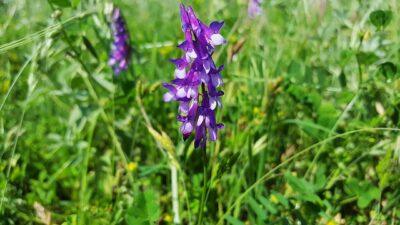Nothing slows the activity on a homestead down as much as wintertime. The bustle of spring planting and calving, and the harvest of summer and fall give way to quieter days of tending livestock, maintaining equipment and feasting on the bounty gleaned from this year’s harvest.
There is something you can do this fall that will quietly work through the winter months – while your laid back and relaxing — to improve the condition of your land. No matter how small the fields, gardens or raised beds on the homestead might be, consider allowing a winter cover crop prepare your soil for the next planting season.
A winter cover crop is valuable in many ways. Winters can be harsh on the land, particularly soil left bare following fall’s harvest. Winter cover crops prevent erosion, which is important not only in maintaining a garden or field, but also valuable for protecting nearby waterways that can be corrupted by too much silt. Cover crops add nutrients back into the soil. Many of these crops also can be used as livestock fodder.
1. Cereal grains
As I drive through the small homesteads that surround us, I see a haze of green rise in the fields each autumn. Many choose cereal or winter rye as the cover crop of choice. There are several benefits to using cereal grains as covers. Their root systems break up compacted soils, reduce erosion and fix nitrogen. If cut before flowering, the cut stalks can be left to decompose and be turned under in the spring, adding nutrients back into the soil.
Looking For Non-GMO Seeds? Get Them From A Company You Can Trust!
These also can be left to harvest as usual if time permits. Oats, barley and wheat can also be used; however, rye produces the largest amount of green material to add back into the soil. Grains and grasses are best used in fields and gardens. Avoid using them in raised beds, as they are more difficult to eliminate.
2. Clover
Though more time-consuming to manage, clover provides a generous supply of green material for your compost pile while improving your soil. Choose crimson clover for a yearly cover, as it is easily eliminated by simply tilling under. Red clover can be used as a biannual crop, while other clovers are perennial and much harder to control as cover crops.
3. Field peas
Field peas can be grown either as a companion crop, under sown during the growing season, or as a winter cover crop. As a winter cover crop, field peas will be killed off from the cold temperatures and left to mulch-in-place, adding nutrients to the soil.
4. Vetch
Similarly, fava beans, or bell beans, are actually a member of the vetch family. It is a popular choice as a cover crop, because it is easier to till under than hairy vetch and less likely to overtake other plantings. Purple vetch is another close relative that is less cold-hardy, which allows it to be left to mulch in-place.
5. Radish
A relatively new addition to the winter cover crop rotation is the radish. Radishes, particularly the daikon radish, provide all of the benefits of a good winter cover crop with very few drawbacks. Radishes break up compacted soil, reaching even into the subsoil. As they decompose after winter killing, they leave empty holes that improve soil drainage and even help the soil temperature to warm more quickly during spring. They are nitrogen fixers, and also draw additional potassium and phosphorus to the surrounding soil.
Planning Your Cover Crop
Starting around September, planting of the chosen cover crop should begin. Time the planting to allow the crop to mature before the first hard frost date for your region. For other crops, such as oats and cereal rye, multiple cuttings may be needed to prevent the crop from reseeding your land. Some cuttings can be used as fodder for your livestock, while other cuttings must be added to the compost pile or left to mulch in the fields.
Growing a winter cover crop will add a bit of work to your fall schedule. However, you will greatly benefit from improved soil conditions come spring.
What is your favorite cover crop? Share your tips in the section below:
Bust Inflation With A Low-Cost, High-Production Garden. Read More Here.
 Off The Grid News Better Ideas For Off The Grid Living
Off The Grid News Better Ideas For Off The Grid Living






